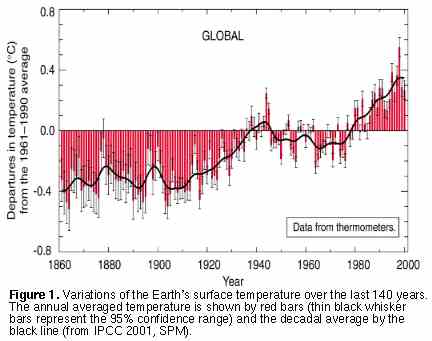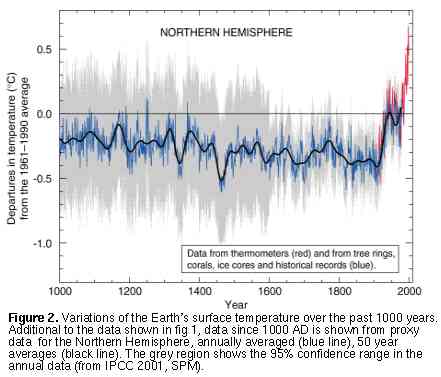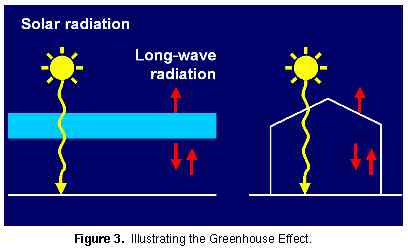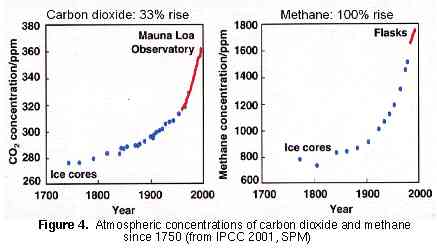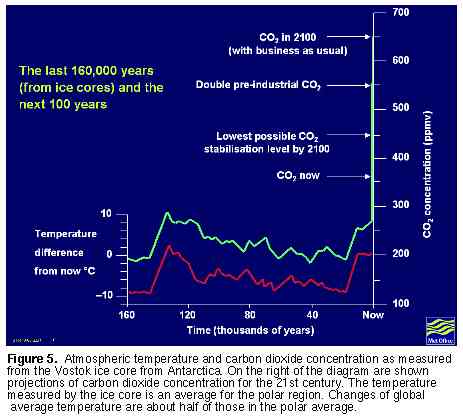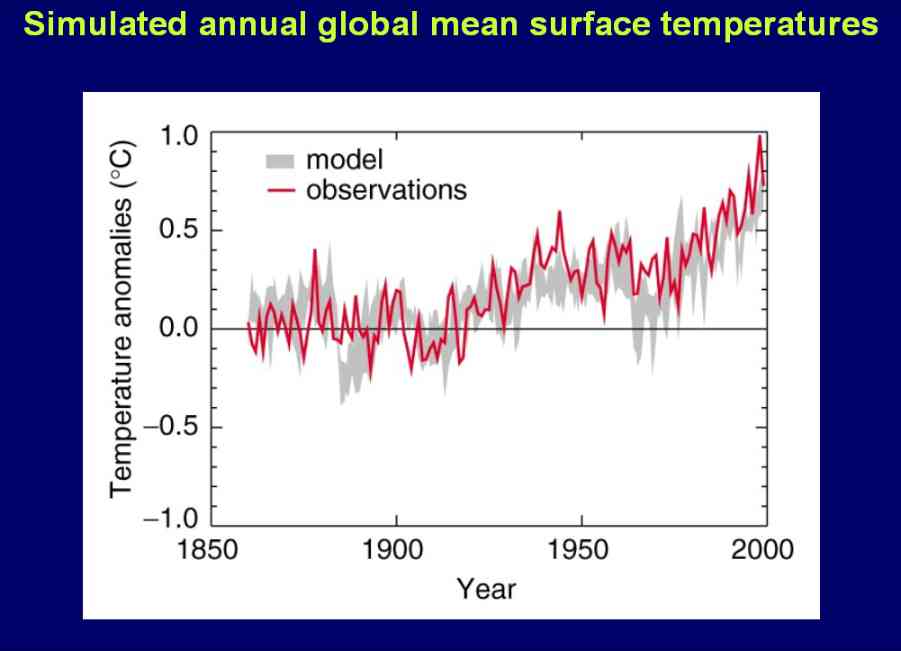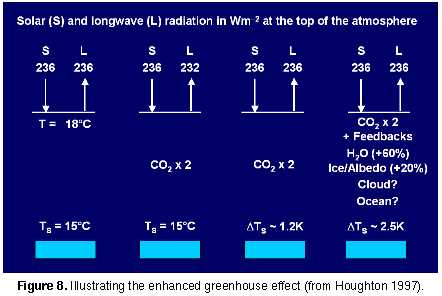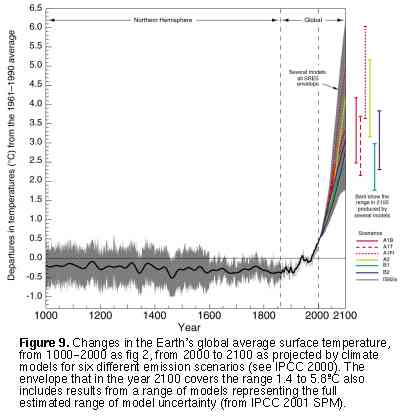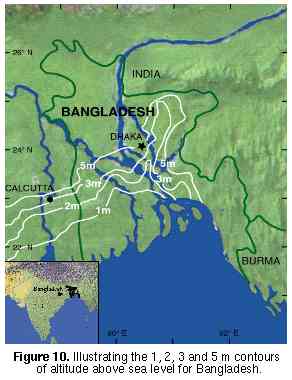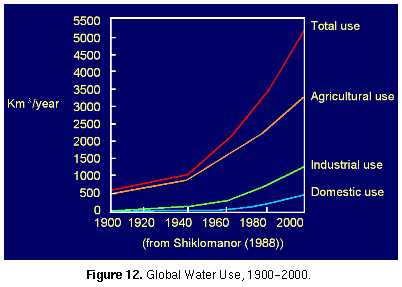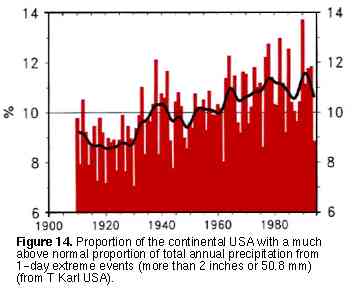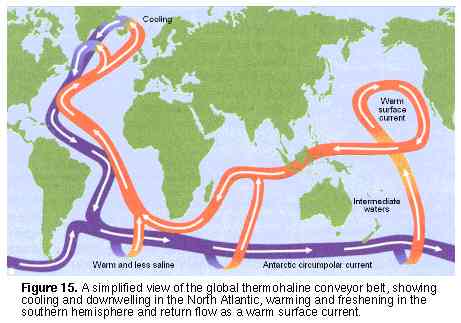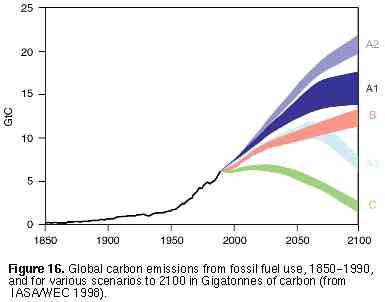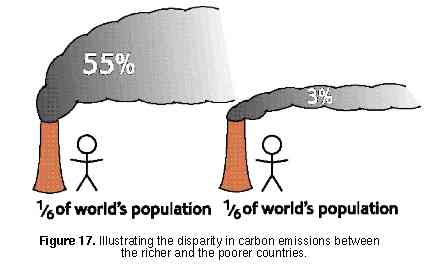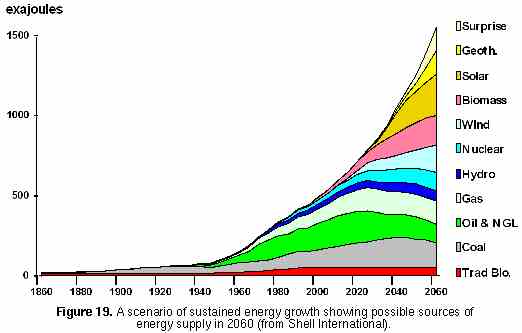Overview of the Climate Change Issue
Presentation to Forum 2002, St Anne’s College, Oxford, 15 July 2002 by Sir John Houghton
What is global warming?
International action on global warming
Reducing carbon dioxides emissions
John Houghton is a well qualified person to give the opening talk to this Forum. He has been deeply involved with the subject of human-induced climate change for some years. He was professor in atmospheric physics in Oxford, then was Director General of the UK Met Office from where he became involved in the IPCC, the Intergovernmental Panel on Climate Change, and the first chairman of the IPCC's scientific assessment. He has continued to be involved as co-chairman of that IPCC Working Group until earlier this year. Without further ado, I will ask John to give us his overview of the climate change issue which is the main subject of this Forum.
In this opening lecture I will outline briefly the scientific basis for human induced climate change, mention the most important impacts on human communities and say a little about the action that is required in terms of adaptation and mitigation. Later lectures in the conference will deal with all these issues in much more detail.
Much more detailed information about the climate change issue, the science, impacts, economics and policy options - can be found in the reports of the Intergovernmental Panel on Climate Change (IPCC) that are available on the IPCC web site (www.ipcc.ch) and in four volumes published in 2001 by the Cambridge University Press under the title of ‘Climate Change 2001’.
Several thousand scientists from a large number of countries were involved in the preparation of these reports and they were subjected to very thorough and extensive review before their publication. The IPCC process and the 2001 IPCC Report has been endorsed by 18 of the world’s leading academies of science including the National Academy of Science of the United States and the Royal Society of London. Much of the material I present here is taken from the IPCC 2001 Report.
First of all let me explain what global warming is about. Around 1900, the French artist Claude Monet visited London and enjoyed the city enormously. He loved the light coming through the smog and if any of you went to the Monet exhibition last year you would have seen paintings with varieties of smog and lots of variations of light. He must, I think, have worn a handkerchief over his nose or had extremely good lungs because London was not a very pleasant place to be in at that time. It is still a polluted city, much more so than it need be, but a great deal better than in 1900.
The problem in London is local pollution largely arising from vehicles that affect the air around them. But we now know there are forms of pollution - global pollution - which individuals in one place may emit and which then affect the whole world. One example of this is ozone depletion by chlorine-containing chemicals. Very small quantities of these emitted into the atmosphere, for instance from leaking refrigerators or from aerosol cans, can reach the stratosphere. This may be only perhaps in parts per trillion, but free chlorine is released that catalytically destroys ozone, rapidly affecting the whole atmosphere.
Global warming is a second and a more important example of this global pollution. Carbon dioxide that I cause to be emitted, because I drive my car or use electricity or in many other ways, enters the atmosphere, and rapidly spreads around the whole atmosphere, much of it remaining in the atmosphere for 100 years or more. Now, because carbon dioxide is a greenhouse gas, it causes the average global temperature to increase, significantly affecting the climate. So everybody in the world is affected.
North Atlantic.
But you will see that the nature and rapidity of the change in temperature over the 20th Century is very different from that over the previous 1000 years. In particular the recent years have been the warmest over that entire period. 1998 was the warmest year in the global instrumental record, and a more striking statistic is that each of the first eight months of 1998 was the warmest of those months in the instrumental record - suggesting that the earth really is warming up.
Why is the earth warming?
Fig 3 illustrates solar radiation travelling through the atmosphere on its way to warm the earth's surface. This incoming energy is balanced by infrared radiation leaving the surface. On its way out through the atmosphere, this infra red is absorbed by greenhouse gases - water vapour, carbon dioxide and methane are the principal ones - that act as a blanket over the earth's surface keeping it warmer. Increasing the amount of these gases increases the greenhouse effect and so increases the average temperature of the earth's surface.
We know for certain that carbon dioxide is increasing because of the burning of fossil fuels - the isotope signatures of atmospheric carbon confirm that. Its increase since the end of the industrial revolution has been about 30% (Fig 4).
Also shown in fig 4 is that methane has approximately doubled since the industrial revolution, very much in line with the growth of human population.
Fig 5 shows the global average surface temperature over a much longer period, including the last ice age which finished about twenty thousand years ago. The last warm period occurred about 120 thousand years ago. The temperatures for these curves are determined from an ice core bored out by Russian scientists from the Antarctic icecap. Such cores are very long - a kilometre or more - and the temperature at which the ice was laid down is deduced from measurements of the ratio of the concentrations of different isotopes of oxygen in the core. The carbon dioxide concentration can be measured from the composition of air in bubbles trapped in the ice. You will notice that the curves of temperature and CO2 content track each other well. Part of this is because carbon dioxide influences the temperature, but it is also because other factors that depend on temperature are controlling the carbon dioxide content in ways that are not yet well understood.
Carbon dioxide levels now are about 365 parts per million. By the year 2100, if we carry on burning fossil fuel in a "business as usual" way without caring about its effects, carbon dioxide concentrations will rise to 600 or 700 parts per million. If the whole world decided to work very hard indeed so as to stabilize carbon dioxide concentrations, we could possibly stabilize at about 450 parts per million. But that is still a very dramatic increase, taking carbon dioxide concentrations far beyond any level they have had in the atmosphere for millions of years.
You may say, "But, of course we'll be due for another ice age sometime soon and such an increase of carbon dioxide could perhaps help to keep us warm or even prevent it coming". We understand quite well what triggers ice ages; it is variations in the earth's orbit round the sun that causes variations in the incidence of solar radiation, particularly in polar regions. These orbital variations are well known from astronomical data and can be precisely predicted; the next ice age is expected in about 50,000 years. As we are likely to use up most of the available supply of fossil fuels in a few hundred years, we will not have much effect on the next ice age!
Radiative Forcing
I will now explain briefly how the influence of increased greenhouse gases on the climate is calculated. Fig. 6 shows the external forcing on the climate system over the last 150 years or so from a number of factors, of which the largest is the increase in the well-mixed greenhouse gases shown at the left of the diagram. Other factors are changes in ozone that is also a greenhouse gas and changes in particles (known as aerosols) in the atmosphere especially, for instance those resulting from emissions of sulphur dioxide from power stations. These sulphate particles tend to reflect sunlight and cool the system; other particles like soot and mineral dust could well be absorbing radiation and warming the system. Careful studies by solar physicists have also been carried out to estimate the range of possible changes in the amount of radiation from the sun over this period; this is shown at the right of the diagram. You will notice that some of the external forcing factors are well known (for instance the increase in greenhouse gases) while others are quite uncertain (for instance the indirect effect of aerosols).
Models?
An important question to ask is whether, given the information in fig 6, the global average temperature over the 20th century can be simulated with climate models. These are computer models that include descriptions of the physics and dynamics of the whole climate system (atmosphere, ocean, land and ice) and that integrate the fundamental equations of motion as a function of time from appropriate initial conditions. A lot of research has gone into such simulations over the last five years that is described in detail in the latest IPCC report. Fig 7 shows the results from four or five of the best models in the world.
On shorter time scales, the models, similar to the real atmosphere, show substantial variability independent of variations in the external forcing. For the longer term variations there is actually quite good agreement. Most of the reason for the recent increase in global average temperature, as I said earlier, is the increased greenhouse gas concentrations. The fact that models can reproduce the observed data with some sophistication provides confidence in the use of models for projection into the future. Confidence in models also comes from model studies of more detailed phenomena (such as the effect on the weather and climate of particular volcanic eruptions) and of climates of the past, for instance of the period 6000 thousand years ago when the radiation conditions were different because of the changes in the earth's orbit.
Fig 8 illustrates the simplest calculation that we can make about the global effects of increased carbon dioxide and it illustrates what we know and what we don't know. On the left of the diagram is shown on average the balance for the earth between the incoming solar radiation, and the outgoing infrared radiation, 236 watts per square metre coming in and 236 watts per square metre going out.
If there were no greenhouse gases in the atmosphere, the average temperature of the earth's surface would be -18ºC or thereabouts. That means the earth's surface would be covered by ice and this lecture would be held in an igloo! The average temperature of the surface is actually about +15ºC so that there is about 20-30ºC of natural greenhouse effect due to water vapour, the strongest greenhouse gas, naturally occurring CO2, and methane.
Now suppose the carbon dioxide concentration in the atmosphere is doubled instantaneously, we can easily calculate what the change in the radiation balance would be. The outgoing radiation at the top of the atmosphere is reduced to 232 watts per square metre, leading to an imbalance of 4 watts per square metre. To bring the system back to balance, the temperature at the surface and in the lower atmosphere has to increase by about 1.25ºC.
That is on the assumption that nothing else changes. But, of course, other things do change: for instance, as the surface temperature increases there is more evaporation, hence more water vapour in the atmosphere. Now, since water vapour is a powerful greenhouse gas, the temperature increases further. In fact there is a positive feedback of about 60%. Also the increased temperature will melt some ice allowing the surface underneath to absorb some sunlight instead of reflecting it back to space - another positive feedback of around 20%.
What about changes in clouds? We still don't know very much about how clouds are influenced by increased temperature. Low clouds provide a negative feedback, because they reflect sunlight rather well; high clouds, because they blanket the earth, like the greenhouse gases possess a positive feedback. We do not know the net effect of clouds with any certainty; it probably varies from place to place and with season. It is the largest unknown in projecting climate for the future. And then we also need to include the effect of increased temperature on the circulation of the ocean and on the way it moves heat around, which could cause substantial regional climate changes.
Taking all these effects into account, the IPCC's best estimate of the global average temperature rise for doubled carbon dioxide is 2.5ºC, with a range of 1.5 to 4.5ºC that allows particularly for the cloud uncertainty. At first sight, such a temperature rise does not seem very large. I suspect the temperature in this lecture theatre has gone up by a degree or two since we walked into it.
But here we are not talking about a local rise of temperature but a rise in the global average.
The difference in global average temperature between the middle of an ice age and the warm periods in between, is only about 5 or 6ºC (see fig 5). So 2.5ºC is about half an ice age in terms of climate change and we're talking about this occurring in about a hundred years; that's a very rapid change in climate compared with changes in the ice ages.
Projections of temperature for this century as estimated by the IPCC from a range of models (fig 9) vary between 1.4ºC and 5.8ºC dependent on what assumptions are made about the amount of carbon dioxide and other greenhouse gases that will be emitted due to human activities. The range also includes allowance for our uncertainty about the response of the climate to increased carbon dioxide. A rise anywhere in this range is very likely to represent a more rapid change of climate than the earth has seen for 10,000 years.
What is the impact of such changes, particularly on human communities? Let me briefly mention two impacts.
First of all, the sea level will rise. Our best estimate is that it will rise by about half a metre by the end of the century with a range of uncertainty between 10 and 90 cm.
The reasons are mainly thermal expansion of the oceans and the melting of glaciers; not, as is often thought, melting of the icecaps. For the oceans, at first, just the top layer is heated, say the first hundred metres, then the next hundred metres and so on. Since there are kilometres depth of ocean to heat, increase of sea level is going to continue for many centuries - even if we succeeded sometime this century in reducing carbon dioxide emissions sufficiently to prevent further climate change. So far as the ice caps are concerned, the best estimates are that Antarctica might grow slightly, the increased snow fall probably being greater than the ablation round the margins. For Greenland, with a temperature rise of more than 3ºC the icecap would probably start a melt down that would take many thousands of years, with an eventual total sea level rise of about 7 metres.
[Added by AB: What makes sea level rise worse is increase in frequency and ferocity of storms. Even without sea level rise, if storms become more ferocious, coastal areas will be devastated more. With sea level rise, the effect will be even greater. ]
Such a rate of sea level rise over the next 100 years would not be too much of a problem for the UK, although the Thames barrier would need modification quite soon and substantial resource would have to go into improved sea defences, especially along the low lying east coast regions. Other developed countries with the necessary resources such as The Netherlands would be able to cope, although it would cost. But the situation would be very different in a poor developing country like Bangladesh, where there are around 10 million people living within 1 metre of present sea level, and where the provision of adequate sea defences along the complicated coastline of the river deltas is not an option. Even more people would be affected in southern China. Many islands in the Indian and Pacific oceans are likely to become uninhabitable and, since a high proportion of the world's population lives close to the coast, many people in other coastal regions would be presented with severe problems (fig 11).
A second major impact is on precipitation and water supplies. It almost goes without saying that water is an important resource. We're using much more water than we used to, some ten times as much a hundred years ago (fig 12), and its use is still increasing, largely because of the demands of irrigation.
And there is enormous competition for water. It was recently reported that the Rio Grande river in north America no longer reaches the sea; it is all used before it gets there - as has been the case with the Colorado river for some time. Butrous Butrous Ghali, the last Secretary General of the UN, said he thought the next war would be about water not about oil, and he may well be right.
So what will happen in a globally warm world? As might be expected, the models all predict increases in average precipitation relating to the increases in temperature. But they are not very good at predicting detailed changes at the regional level. However, a robust result from all models is that heavy rainfall will tend to get heavier, and light rainfall will often tend to get lighter (fig 13).
It is quite easy to understand why that might be. In a warmer world more water is evaporated from the surface, more water vapour enters the atmosphere and more water vapour condenses to form clouds. Since the latent heat of condensation of waters vapour provides the main energy source for the atmosphere's local circulations, the hydrological cycle will become more intense. It is not surprising therefore that heavy precipitation will tend to become heavier. But why does lighter rainfall tend to become lighter? That is because, in a more intense hydrological cycle, uprising currents in the atmosphere will tend to go higher, where it's colder and dryer. So the air in the downdraughts will tend to be dryer.
So in some parts of the world, there will be a tendency to increased floods and in others, increased droughts. There is evidence that this increased tendency to heavy rainfall events is occurring already (fig 14), with an increase of a few percent in many parts of the US over the past century.
How does this impact on human activities? Taken together, floods and droughts are the biggest disasters the world knows. They cause more loss of life, more damage, more misery, more economic loss, than any other disasters we know. An increase in the frequency and intensity of floods and droughts will be of substantial concern to countries at mid latitudes, like the UK, the USA or China, that possess at least some of the necessary infrastructure to respond to such problems. But in sub-tropical regions where there are developing countries much more fragile in their agriculture, their living and their ability to cope, the impacts will be much greater. We know something of their vulnerability from the two floods in Mozambique in the year 2000 and from droughts in Ethiopia and Eritrea in 2001 and more recently in other parts of Africa.
Although, because of the large natural variability of climate, we cannot say that any given flood or drought is a result of global warming, we can say with some certainty that we expect them to occur in the future with more intensity and frequency. Because of this, there is a great deal of interest in the El Niño phenomenon, a large climatic variation that occurs about every five years associated with unusual warming of the Pacific ocean close to south America. Associated with El Niños are climate extremes such as floods and droughts, particularly in the Australian, African and American continents. The 1980s and 1990s have seen some unusual El Nino events and a number of researchers are investigating the evidence for the possibility that El Niños may become more intense as global warming occurs.
Due to the two impacts I have mentioned, substantial numbers of people are likely to be displaced. Norman Myers working at Oxford1 has estimated the number of refugees that might occur because of sea level rise and because of disruption of agriculture due to precipitation changes. It's a fairly conservative study, but he estimates that there could be perhaps 150 million refugees by the year 2050. That is a very large number, for example it is half the population of the USA. It is not, of course, an easy estimate to make and his assumptions may be open to question, but it provides some indicator of the extent of the possible impact of global warming.
How do these and other impacts translate into economic terms? Estimates are not, of course, easy to make, but most studies suggest that the damage, associated with a doubling of atmospheric carbon dioxide concentration, will represent in developed countries a loss of about 1% of GNP, and in developing countries possibly 5%, or even 10% of their GNP. But then such studies do not quantify the disruption or misery or the refugee problem that are hard to represent in money terms.
There is a further possible impact I should mention that is connected with the ocean circulation. A major source for the deep ocean circulation (fig 15), a ‘conveyer belt' as it's sometimes called, is located in the North Atlantic between Greenland and Scandinavia.
Water there that has travelled northwards from the region of the Gulf of Mexico is cold and also comparatively salty because of the evaporation that has occurred on its journey. It is therefore more dense than the water around and tends to sink to the bottom, providing much of the source water for this slow, deep, snakish current.
Now, in the warmer, wetter world we are expecting quite a lot more rainfall, particularly at higher latitudes, which will introduce more fresh water into that part of the ocean. The water will become less salty and will not sink so readily. All models with coupled atmosphere-ocean circulations show that circulation weakening as the carbon dioxide in the atmosphere increases. Some models show it cutting off in a few hundred years. We know that this can occur because palaeo records show that it has occurred at various times in the past.
What impact would that have? It could have a significant impact on northwest Europe. No model suggests that this region would be colder, but it would be likely to be less warm than it would otherwise be. In some places that might be seen as an advantage although, because of the increased land-sea temperature contrast, stronger winds might also be a consequence. I mention it, not only because of its scientific interest, but because it demonstrates the possibility of inadvertently altering major systems of the atmosphere and of the ocean that could cause climate changes in ways that we do not well understand as yet.
[Added by AB: I was told a decade ago that wind patterns would change, such that, for example, Britain would receive more wind from the north and east e.g. Siberia during the winters, making British winters colder. This is exactly as occurred in 2010! but I don't know whether it is still generally believed in the scientific and meteorological communities.]
I've mentioned some of the deleterious impacts of climate change. Are there likely to be beneficial impacts as well? More very hot days will be difficult to cope with, especially in some cities but less cold days will tend to bring benefits. At northern latitudes in Siberia or northern Canada, a longer growing season is likely to provide for more and possibly different crops. Increased carbon dioxide also acts as a fertiliser for some plants and again, if other conditions are also right, could lead to higher agricultural production. This higher production is likely to occur in developed countries at mid-latitudes. By contrast, many developing countries may not be able to produce as much for their increasing populations.
So there are factors which are positive; but careful consideration of the impacts demonstrates that negative ones outweigh the positive ones. Most of the reasons for this arise from the very rapid rate of change that is expected and the difficulties for both humans and ecosystems to adapt. In some cases, ecosystems cannot move or regenerate fast enough to survive, so the connection between global warming and biodiversity is also a serious issue.
Now let us turn to what the world is doing about the problem. So far as world science is concerned, I have already mentioned the IPCC and its work in producing authoritative assessments. The influence of the IPCC 1990 assessment assisted the world's politicians meeting in Rio in 1992 in the formulation of the Framework Convention on Climate Change (FCCC) - a new convention to which countries agreed and which President George Bush signed for the United States. The FCCC's stated objective is the stabilization of greenhouse gas concentrations in the atmosphere at levels and on a time scale that would prevent dangerous anthropogenic interference with the climate system' and that are consistent with sustainable development. Since then regular meetings of the Parties to the Climate Convention have been considering the action that should be taken. The Kyoto Protocol, agreed in 1997, formulates arrangements for the first binding commitments by nations. Ratification of that Protocol by enough nations to bring it into force is expected by the end of 2002.
Let me digress now for a minute and consider just why we should be concerned about climate change. It is a problem that is well downstream; many of us will not be much affected ourselves but it is going to affect our children and our grandchildren. We are bound to ask therefore questions about the sort of relationship we should have to the earth that is our home and to the rest of creation with whom we share the earth.
Let me suggest that a helpful picture of this relationship can be found in the early chapters of the Judaeo-Christian scriptures. Humans were placed in a garden to care for it. We are encouraged to see ourselves as gardeners of the earth.
Gardens suggest four things. They are there to provide food, water and resources for us, for human life and industry. They are also places of beauty and diversity - we cherish and spend time in our gardens and we visit special gardens - all part of our human enjoyment. We like to think that other living creatures also enjoy gardens too. The birds that join the dawn chorus at four in the morning obviously enjoy it very much. And then gardens are places where we can be creative: we landscape them and create new varieties of plants or other creatures for beauty and for benefit. Our science and technology can helps us to be better gardeners and to make the world a better place; although, just how technology should be applied is something we need to debate carefully. Finally, gardens are there for future generations. And that is something that those of us who have children and grandchildren, certainly appreciate. It is our children and our grandchildren who will experience the impacts of climate change. I remember in 1990 when the first IPCC report came out, the Prime Minister, Margaret Thatcher showed a lot of interest. I was invited to present it to her cabinet at the time. As I walked out of that meeting, one of the cabinet ministers asked me, "When's all this going to happen?" I replied that in 20 or 30 years we can expect to see some large effects. "Oh" he said, "that's OK, it'll see me out". But it won't see his children or grandchildren out.
Christians and other religious people believe that we've been put on the earth to look after it. Creation is not just important to us, we believe also it is important to God and that the rest of creation has an importance of its own: for these reasons we should be good gardeners. But in many ways we are not being good gardeners. Let me give you just two examples, other than the one of global pollution I've been talking about. We've already lost or seriously degraded some 10% of the garden's soil - a loss that continues largely unabated because of erosion and bad practice. Then, we are destroying forests, important forests. When I say "we" I mean "we" the human race of which we are part. We are party to the destruction, we allow it to happen, in fact it helps to make us richer. We really need to take our responsibility as ‘gardeners' more seriously.
Let me return to climate change and what action can be taken. Much of the action has to be taken in the energy sector because most of the carbon dioxide that enters the atmosphere comes from energy production or use. Fig 16 shows anthropogenic carbon dioxide emissions since the industrial revolution; it also shows projections to the year 2100 made by the World Energy Council (WEC, the body that links the world's energy industries) under different assumptions.
Curves A and B in fig 16 are "business as usual" projections, with large growth in emissions and even larger growth in energy use. Curve C the WEC describe as the ‘ecologically driven' scenario. The WEC believe curve C to be achievable, but only if we are really serious about being more careful and efficient in our use of energy, and also if we stimulate rather rapidly the growth of energy generation from renewable resources. Under projections A and B, carbon dioxide concentrations continue to rise to 600 or 700 ppm by 2100. Curve C is the only projection of the three that approaches stabilization of carbon dioxide at around 450 ppm.
A scenario such as C in fig 16 will only be realized if there is concerted international action. There are three principles that are frequently put forward as those that should govern such action. First there is the Precautionary Principle that is included in the Climate Convention and that states that that the lack of full scientific certainty should not prevent appropriate action being taken. The second is that polluters should pay for the damage of their pollution, a well known principle that has been built into environmental legislation for a long time. It can be applied, for instance, through the taxation of pollution or through the setting up of trading arrangements.
The third principle, the most difficult to apply, is that of equity - intergenerational equity and international equity. At the moment 55% of carbon dioxide emissions are produced by the richest one sixth of the world's population (fig 17), the United States alone being responsible for 25%. Just 3% is emitted by the poorest one sixth of the world. There is obviously a great inequity here.
The Climate Convention recognizes this inequity by a clause that states that, because the industrialized countries have benefited so much from fossil fuel burning, they should take the lead and the first action in combating the problem and reducing their emissions. The formulation of the Kyoto Protocol follows this lead.
To illustrate the sort of action that is necessary and the associated difficulties, I present a proposal put forward by the Global Commons Institute called Contraction and Convergence shown in fig 18. The envelope curve in the figure shows a profile of emissions that would stabilize atmospheric carbon dioxide at about 450 ppm although very similar diagrams could be produced for different stabilization levels. The first part of the proposal is that the world as a whole agrees to follow that envelope curve - that is the contraction part of the proposal.
Also shown is the share of emissions up to the present from different countries or groups of countries. The second part of the proposal is that eventually, say from 2030, carbon dioxide emissions should be allocated to countries so as to share the emissions equally between all human beings. From 2030, the figure illustrates that allocation. Between now and 2030, emissions from countries need to converge to their 2030 allocations.
You will immediately say that such goals are completely unrealistic. But there is a third part of the proposal that allows for trading of emissions. Those that have more than they need can sell to those who want to emit more. The effect of the trading would be to move money from rich nations to poor nations; that money could be used to help poor nations industrialise in sensible ways and to develop appropriate non fossil fuel energy systems.
Now you will see enormous problems, political, practical and even possibly ethical by the details of the Contraction and Convergence proposal, or indeed of any other proposal that can be envisaged. But is does well illustrate some of the essential principles that have to underlie the necessary action and the scale and the enormous challenge it presents to all countries of the world.
Let me now turn from the politics and in considering the practical changes that could be made in energy use, I will just use the example of buildings. About 40% of electricity is used in buildings. Much can be done to reduce this at little or no cost - or in many cases with actual savings in cost. Better building standards, better heat insulation, more efficient lighting, use of direct solar energy to heat buildings, use of local combined heat and power plants are just some of the possibilities. The basic technology to do a great deal is already available. But it is not enough to demonstrate what can be done on a few demonstration buildings. Millions of buildings have to be brought to a much higher standard of energy efficiency. That is a very large challenge to governments, to industry and indeed to all of us.
Changes have not only to be made in the way we use energy; changes are also required in the way energy is generated. We have to move away from using fossil fuels and learn to use renewable energy sources such as biomass (eg fast growing willow), wind and solar energy.
Again, much of the technology is available but resources and incentives need to be put into place to enable growth of renewable energy on the scale required. The UK is slow in this compared to some other developed countries, Denmark and Germany for instance. Fig. 19 shows a projection by the Shell company of substantial growth in energy production and use by the year 2060, but with the global use of fossil fuel down to 2000 levels and over two thirds of the energy sources being non fossil fuel.
How about the cost of action to mitigate global warming, in particular to stabilise carbon dioxide concentration in the atmosphere as required by the FCCC and so to stabilise climate?
Studies by economists suggest that, providing the action is phased over, say, 20-50 years in a sensible manner, for instance to take account of the normal timescale for infrastructure replacement, the cost of stabilising carbon dioxide at say 400-500 ppm would be, on average, less than 1% of countries' GNP. This is substantially less than estimates I mentioned earlier of the economic cost of the damage if we do nothing, even if the unquantifiable damages are ignored.
In the Domesday Lectures on Radio 4 in the UK given 3 or 4 years ago, Sir Crispin Tickell said "we know what to do but we don't have the will to do it". Lack of will is not a new problem, of course, for humans. It is largely a moral and spiritual problem, one that St. Paul presented in his letter to the Romans (Romans 7 v18) in the New Testament commenting that he had not completely solved it for himself in his own experience. People often say to me, "the problem is so big, it will never be solved; you're not going to get anywhere, the politicians will never agree, greedy people will never change their ways." So, why am I optimistic?
Let me give you three reasons. First, I have experienced the scientific community, many hundreds of scientists from a wide range of countries, ideologies, disciplines and backgrounds, come together with great commitment to agree a scientific assessment of likely climate change. Secondly, the necessary technology is available, or is becoming available and industry is beginning to see climate change as an issue that provides great opportunities for technical advance. And thirdly, I am a Christian, and I believe that God is committed to his creation, a commitment he has demonstrated by sending Jesus into the world to be the saviour of the human race. In delegating to humans the care of his creation, God has not left us to do it on our own. That he is there to help us with the great task has been a great source of strength to me in my work with the IPCC. I felt this particularly strongly as a few of us met for prayer during the very demanding IPCC Plenary in Shanghai.
Finally let me comment again on the need for commitment. If human communities are to be fulfilled and creative, they not only need goals related to economic performance but also moral and spiritual goals. Care for the overall health of the planet is such a goal. Scientists are already working hard and in concert to provide better information about likely climate change, governments in the FCCC have begun to set the necessary framework for change, and business and industry are beginning to recognise the need for action and the opportunities for innovation in new technologies. It is up to all of us as world citizens to support the action being taken and contribute to it.
Let me finish with a quotation which comes from Edmund Burke, a British parliamentarian of 200 years ago, who gave a great environmental message. He said "Nobody made a greater mistake than he who did nothing because he could only do a little".
Further detailed information about Global Warming can be found in the IPCC 2001 Report, "Climate Change 2001" published in 3 volumes ('The Scientific Basis', 'Impacts, Adaptation and Vulnerability', and ‘Mitigation'), by Cambridge University Press 2001.
John Houghton, "Global Warming: the complete briefing", 2nd edition, Cambridge University Press 1997 provides a comprehensive account of the science, impacts and mitigation of Climate Change.
A challenging assessment of the potential for increases in energy efficiency can be found in E vWeizsacker, A B Lovins and L H Lovins, “Factor Four; Doubling Wealth, Halving Resource Use” Earthscan Publications 1997.
Detailed projections for the global energy industry are given in 'Global Energy Perspectives, a IASA/WEC Report' (ed N. Nakicenovic, A Grubler and A MacDonald) Cambridge University Press 1998.
Details of IPCC Emission Scenarios are in ‘Emission Scenarios - an IPCC Special Report' Cambridge University Press, 2000.
Further details of impacts studies can be found in ‘Climate Change and its Impacts: a Global Perspective', published by the UK Meteorological Office 1997.
Sir John Houghton was Co-chair of the Scientific Assessment Working Group of the Intergovernmental Panel on Climate Change and was formerly Chief Executive of the Meteorological Office, and a member of the Government Panel on Sustainable Development, and from 1991 to 1998 was Chairman of the Royal Commission on Environmental Pollution. He has written several books including Global Warming: the complete briefing and The Search for God: can science help? Sir John writes and lectures widely on the relationship between Christian faith and environmental concerns.
Chairman's introduction
Introduction
What is Global Warming?
The Impacts of Global Warming
Sea Level Rise
Impact on Water Supplies
Impact on Human Activities
International Action about Global Warming
Why should we be concerned?
Reducing carbon dioxide emissions
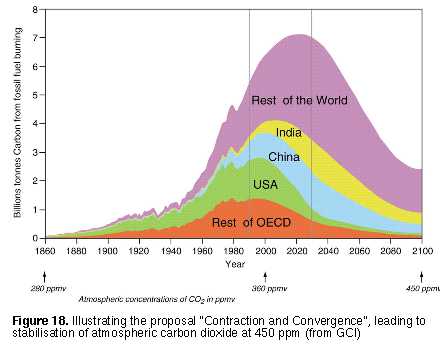
Can we be optimistic?
Bibliography and References
The Speaker
